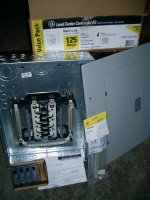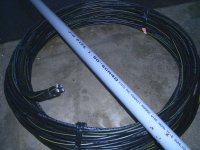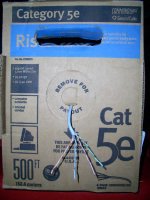You are using an out of date browser. It may not display this or other websites correctly.
You should upgrade or use an alternative browser.
You should upgrade or use an alternative browser.
So I got a good deal on some trusses...
- Thread starter dholly
- Start date
- Views: 21522
/ So I got a good deal on some trusses...
#51
My electrical knowledge is basic at best. After searching around on TBN for some enlightenment, I concluded a 125A 24-space subpanel w/ separate neutral bar was a good choice. I found this GE panel and (4) 20A breaker package for $32 and the 24 terminal bar was $4. I know in the near future I will have a welder and it seems like this should be sufficient. Yes?
Attachments
After consulting the book for drop, based on my approx. 80' run from house to shop, 2/0 Awg 4-wire would be fine for 125A. I went with the 4-wire because with the soil here, I didn't care to pound 2, maybe 3, 8' grounding rods in. Bot 90' for $0.95/ft. This IS the right stuff, right?
Attachments
After talking with the inspector, I have decided to run the 4-wire electric service in the 1-1/2" Sch 40 conduit rather than bury direct. Also, I have some 4-Pair Cat5 laying around and think this might be the best way to get a lot of wire for alarm, telephone and computer into a 1" conduit along with the TV cable. If I pull (5) Cat5 that gives me 20 pairs, enough for everything plus a few spares. Sound ok, right?
Attachments
This show the electric service inside on the house end. The new line will enter the house right between the floor joists just inside the existing service elbows at top. The cable TV and telephone enter the house right here as well, and the primary alarm box is within about 4'. That was pretty darn handy!
Attachments
Need help with emergency generator wiring design from shop to house please.
I'm trying to understand how to do this but, like I said, I am electrically challenged. Actually, right about now I feel ignorant may be the better word. Obviously I need to do this correctly for safety's sake and, in case I need to run extra wire, thinking I need answers while my trench is still open. I've searched "generator feed thru sub panel" with little success. Seems like most of the discussion is buried in 'related' type threads like THIS excellent old thread. But, trying to go thru all this content is like trying to find a needle in a haystack, so maybe you'all could lend a hand...
My goal is to have a 3-pt PTO generator located at the shop, or maybe even a whole house UtterPower project down the road. Can I use the 4-wire 2/0 Awg service line I am burying now to safely backfeed the main house panel(s) or for some reason do I need to bury more wire back to the house? I suspect I could use a double male plug cord to back feed and throw the house Mains in a pinch (I don't want to start another safety discussion on that here). But I don't care to risk killing anybody, including myself, so I have decided to do a proper, permanant metered transfer switch install. Any reason it can't be out in the shop? Also, seems to me I will want a single circuit type switch so I can manually pick and choose which circuits to run in the house by flipping unnecessary circuit breakers? I like the idea of flexible circuits and not being limited to only a handful of dedicated circuits. Primary needs are well, fridge, sump pump and lights. The rest of the house is electric, heat pump, stove, water heater etc. Of couse, a light and power outlet or two in the shop would be necessary. I am limited with 18hp (PTO) from my 24hp B7610 but don't really want to use a large gas[hog] generator or put in a propane fuel source.
What is the most cost effective way to accomplish this safely to NEC? Budget constraints require me to run all the wiring in the new garage/shop and have final connections made by a lic. electrician before inspection so your help is greatly appreciated. Please, go lite on the techno if you can, I need a easy to understand K.I.S.S. solution! /forums/images/graemlins/blush.gif Thanks.
I'm trying to understand how to do this but, like I said, I am electrically challenged. Actually, right about now I feel ignorant may be the better word. Obviously I need to do this correctly for safety's sake and, in case I need to run extra wire, thinking I need answers while my trench is still open. I've searched "generator feed thru sub panel" with little success. Seems like most of the discussion is buried in 'related' type threads like THIS excellent old thread. But, trying to go thru all this content is like trying to find a needle in a haystack, so maybe you'all could lend a hand...
My goal is to have a 3-pt PTO generator located at the shop, or maybe even a whole house UtterPower project down the road. Can I use the 4-wire 2/0 Awg service line I am burying now to safely backfeed the main house panel(s) or for some reason do I need to bury more wire back to the house? I suspect I could use a double male plug cord to back feed and throw the house Mains in a pinch (I don't want to start another safety discussion on that here). But I don't care to risk killing anybody, including myself, so I have decided to do a proper, permanant metered transfer switch install. Any reason it can't be out in the shop? Also, seems to me I will want a single circuit type switch so I can manually pick and choose which circuits to run in the house by flipping unnecessary circuit breakers? I like the idea of flexible circuits and not being limited to only a handful of dedicated circuits. Primary needs are well, fridge, sump pump and lights. The rest of the house is electric, heat pump, stove, water heater etc. Of couse, a light and power outlet or two in the shop would be necessary. I am limited with 18hp (PTO) from my 24hp B7610 but don't really want to use a large gas[hog] generator or put in a propane fuel source.
What is the most cost effective way to accomplish this safely to NEC? Budget constraints require me to run all the wiring in the new garage/shop and have final connections made by a lic. electrician before inspection so your help is greatly appreciated. Please, go lite on the techno if you can, I need a easy to understand K.I.S.S. solution! /forums/images/graemlins/blush.gif Thanks.
Farwell
Veteran Member
Suggestion, contact the electrician that will do the final hook up and inspection. Generally I have found them to be more than helpful. I have done quite a bit of reading associated with electrical grounding and this seems to be a critical area associated with installing a generator system. Cheaper and much safer in the long run. Local codes also may apply.
khd
Gold Member
I won't speak to the generator question but the cat5 is good. You can also use it with low voltage (12 to 24 V dpending on distance) to operate contactors so you can control high power from a distance, i.e. turn a light, compressor, etc. on and off. plus everthing else you want, security, phone and the like. Home Depot sells punch blocks and bridge clips that make terminating all that wire nice and neat. Then use the block to pull whatever you want off of it. Also, make sure you terminate each end of your RG on a ground block and use good fittings, might need an in-line amplifier if the signal is weak or ghosty.
Sounds and looks like a nice project. Keep updating.
Regards,
Kevin
Sounds and looks like a nice project. Keep updating.
Regards,
Kevin
JimMorrissey
Veteran Member
dh,
This might be a good time to consider laying down some PEX tubing in the slab before you pour. It will be an excellent and efficient way to heat the building....whether you intend to heat it now or not. It will make the building far more valuable in the future and very comfortable in the winter. Radiant heat is nice to melt the snow off the cars too and dry them out a bit.
Once the concrete is poured you can't go back. That amount of PEX isn't too expensive and you and another person could zip tie it to the wire in one afternoon. -Doesn't have to be perfect, just get it down and you'll be a happy camper.
This might be a good time to consider laying down some PEX tubing in the slab before you pour. It will be an excellent and efficient way to heat the building....whether you intend to heat it now or not. It will make the building far more valuable in the future and very comfortable in the winter. Radiant heat is nice to melt the snow off the cars too and dry them out a bit.
Once the concrete is poured you can't go back. That amount of PEX isn't too expensive and you and another person could zip tie it to the wire in one afternoon. -Doesn't have to be perfect, just get it down and you'll be a happy camper.
Farwell - I surely will, however on a Sat. day off, he's nowhere to be found and I know TBN never sleeps! I know local codes/inspectors may come into play, but here is the pertinent NEC grounding info from the thread I linked above.
per Inspector501 -
</font><font color="blue" class="small">( Okay, I decided to post a reply to myself and try to clear up what the NEC® says about running power to a separate building as far as grounding/bonding.
(1) If you only run one branch circuit, and include a grounding conductor, no electrode or neutral bonding is required. But a connection to the neutral is not to be made.
(2) If you run a feeder to the building with no equipment grounding conductor, a grounding electrode must be installed and the neutral bonded to that electrode and the panel enclosure. This is provided you do not have any continous metallic paths back to the main building such as metal water/air lines, etc. And provided you do not have ground fault protection for EQUIPMENT. The average residential property will not have GFPE which is different than a GFCI
(3) If you run a feeder with an equipment grounding conductor, a grounding electrode must be installed at the building and connected to the grounding conductor in the feeder and to the enclosure.
All of this is in NEC® 250.32
)</font>
For reference -
**** NEC ****
Reference NEC 250-32
Buildings or Structures Supplied by a Feeder or Branch Circuit.
This states that two options are allowed for a grounded system.
1) Run an equipment grounding conductor with the supply conductors. DO NOT use the bonding jumper in the electrical panel which ties the neutral (grounded conductor) to the ground.
2) When an equipment grounding conductor is NOT run with the supply conductors, AND no continuous metallic path exists between the systems, AND ground fault protection of equipment has not been installed on the common AC service; THEN, DO USE the bonding jumper at the panel.
**** NEC ****
per johnbilt -
</font><font color="blue" class="small">( Note that NEC 250-50 states that all structures and buildings shall have a ground electrode system as described. The issue discussed above is how the bonding jumper is handled. Most residential applications are fed from one panel and therefore this issue is not raised. The neutral is tied to the grounding jumper at the main panel only and provides the required single bonding point. When outbuildings with a new panel are installed, the above issue dealt with in NEC 250-32. )</font>
Now I have to figure how to tie in the transfer switch in the outbuilding and whether it has an impact on the above.
per Inspector501 -
</font><font color="blue" class="small">( Okay, I decided to post a reply to myself and try to clear up what the NEC® says about running power to a separate building as far as grounding/bonding.
(1) If you only run one branch circuit, and include a grounding conductor, no electrode or neutral bonding is required. But a connection to the neutral is not to be made.
(2) If you run a feeder to the building with no equipment grounding conductor, a grounding electrode must be installed and the neutral bonded to that electrode and the panel enclosure. This is provided you do not have any continous metallic paths back to the main building such as metal water/air lines, etc. And provided you do not have ground fault protection for EQUIPMENT. The average residential property will not have GFPE which is different than a GFCI
(3) If you run a feeder with an equipment grounding conductor, a grounding electrode must be installed at the building and connected to the grounding conductor in the feeder and to the enclosure.
All of this is in NEC® 250.32
)</font>
For reference -
**** NEC ****
Reference NEC 250-32
Buildings or Structures Supplied by a Feeder or Branch Circuit.
This states that two options are allowed for a grounded system.
1) Run an equipment grounding conductor with the supply conductors. DO NOT use the bonding jumper in the electrical panel which ties the neutral (grounded conductor) to the ground.
2) When an equipment grounding conductor is NOT run with the supply conductors, AND no continuous metallic path exists between the systems, AND ground fault protection of equipment has not been installed on the common AC service; THEN, DO USE the bonding jumper at the panel.
**** NEC ****
per johnbilt -
</font><font color="blue" class="small">( Note that NEC 250-50 states that all structures and buildings shall have a ground electrode system as described. The issue discussed above is how the bonding jumper is handled. Most residential applications are fed from one panel and therefore this issue is not raised. The neutral is tied to the grounding jumper at the main panel only and provides the required single bonding point. When outbuildings with a new panel are installed, the above issue dealt with in NEC 250-32. )</font>
Now I have to figure how to tie in the transfer switch in the outbuilding and whether it has an impact on the above.




